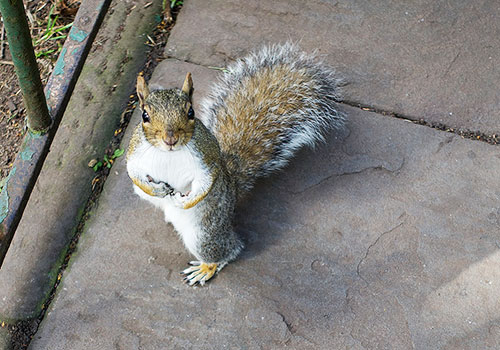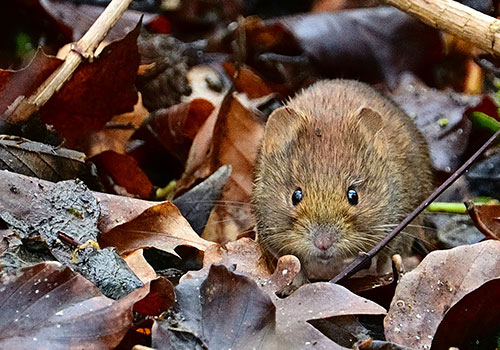Pest Damage ID Part 3: Who’s destroying my garden?
Creepy crawlies may come to mind first when we think about garden pests, but birds and mammals can sometimes cause us even more trouble. Damage from smaller critters might look like holes or discoloration. But when it comes to uprooted plants, heavily nibbled veggies or flowers, seeds snapped right up out of the ground, or even entire small plants disappearing, we’re probably dealing with a bird or mammal.
The trouble with these adorable macro-pests is that they can do a lot of damage all at once, and they are way too smart. Meanwhile, completely eradicating them is usually not a practical, safe, or legal option. We always recommend a holistic, ecological approach to pest management, and this mindset is especially important when it comes to managing damage from vertebrate pests. In general, ecologically responsible management for bird and mammal pests is more about protecting your plants than it is about doing anything directly to the animals.
The first step to limiting damage from these sorts of pests is to know who we’re dealing with. Let’s take a look at some of the most common suspects.
Squirrels
These fluffy-tailed little bandits are so ubiquitous and controversial in local gardens that we wrote a whole post about them. If someone has been digging up your freshly planted bulbs, climbing up your sunflowers to eat the developing seed heads, or snagging your larger fruit and nut crops from the treetops, it's probably a squirrel.
Squirrels do their foraging during the day and sleep at night. They also aren’t particularly subtle. So if you want to confirm that they’re your culprit, it’s usually pretty easy to catch them red-pawed.
Perhaps the most frustrating thing about squirrels, from a gardener’s perspective, is their enthusiasm and expertise at digging up freshly planted bulbs. Luckily, there are a few tricks you can use to deter them.
They love to eat most of the bulbs that we love to plant, from tulips to crocuses. But there are a few that they’re less fond of. These include daffodils, alliums, hyacinth and fritillaria. Unless they are extremely hungry, they are likely to pass these options by.
When you do plant bulbs that squirrels like to eat, you can protect them by laying down chicken wire over the planting area and tacking it down with edging stakes. You can then add a layer of leaves or bark mulch over the top to preserve your garden’s aesthetics. Tucking bulbs in among existing vegetation and adding sharp gravel to the planting area may also help protect your plantings.
Holding off as long as possible on fall bulb planting may also help: squirrels tend to throw themselves into foraging early in the fall and slow down as they successfully stock up. We’re lucky here in the Pacific Northwest that we can plant late into the fall, so we can wait out their fiendish foraging frenzy.
Major issues with squirrels eating fruits and nuts or damaging trees are less common. If you do have this problem, you can deter squirrels from climbing trees by pruning so that the branches start at least 5’ above the ground, and placing a metal or plastic sleeve around the trunk. You can also protect fruit and nuts from squirrels and other pests with netting.
If you would like to save sunflowers and other seeds to plant or to eat, you can place a paper bag tied with twine or other barrier around them to deter hungry squirrels.
Unfortunately, intentionally feeding squirrels is more likely to attract additional pests to your garden rather than deterring them from eating your bulbs and crops.

Rats
Whether we like it or not, rats thrive alongside humans. Wherever there are lots of us, there are likely a lot of rats quietly coexisting in all those nooks and crannies we love to create, and living on the abundant scraps we tend to leave behind.
This usually becomes a problem for gardeners only when the rat population really gets out of control. When we wake up to partially nibbled fruits and vegetables lying around the garden after a night of nocturnal feasting, there’s a good chance we’re dealing with rat overload.
Let’s face it: if we try to battle rats head-on, we’re going to lose. They have thrived in and around our homes for centuries by being extremely good at evading us, and that isn’t about to change. We can try all kinds of traps and we might catch one from time to time, but it’s going to be a long and frustrating game. We can resort to poisons, but those can harm the whole ecosystem, not to mention our own pets.
What we can do is discourage rats from building up huge populations in our gardens. To do this, we need to understand what they need to thrive and then keep supplies of those resources in check. If you believe that you have a rat problem, here are some steps you can take:
- Cut back grass and tall groundcover. Ivy, tall grass, and weedy underbrush provides excellent cover for rats. They especially love when nice, safe brushy areas grow right alongside buildings and other structures that they use to navigate by touch. Cutting groundcover back away from buildings and down to a shorter height will make them feel a little less cozy.
- Keep meat, dairy, legumes, and grains out of any open compost piles, and only feed pets indoors. If you keep any grains, seeds, or pet food in an outdoor structure like a shed or chicken coop, store it in secure containers. Rats do like fruits and veggies, but they are omnivores like us and they need a varied diet. If your garden produce is the only food source nearby, they’ll at the very least need to range further to search for other foods.
- Reduce debris and clutter that rats can use for cover, especially near buildings.
- Remove as many sources of standing water as you can. Rats need water to drink just like anyone. Along with limiting food sources, limiting water access will make your garden a little less hospitable to rats.
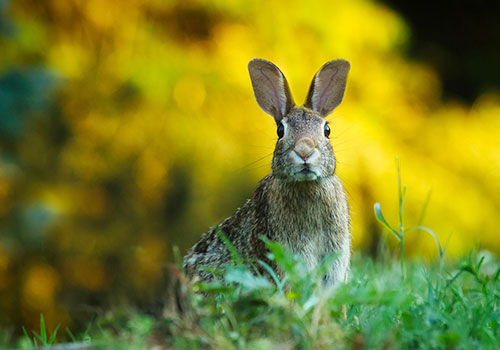
Rabbits
Eastern cottontail rabbits are common in urban and suburban areas around here, and they can cause a lot of trouble in our gardens! They will nibble on just about any garden produce, but their favorite foods are tender young seedlings. If you find that the tops of your growing plants cleanly clipped off overnight, a rabbit may very well be your culprit.
These wild rabbits nest above ground rather than digging burrows, so your bunny pest may not be far from the scene of the crime. Try making some noise around any tall groundcover or dense underbrush you might have on site to see if you can uncover a hiding spot. Needless to say, cutting back and limiting this kind of cover can also help deter rabbits.
If you have a serious rabbit issue on your hands, fencing your vulnerable plants might be your only real option. Your fence should be at least two feet tall so that bunnies can’t jump over it, and extend at least six inches into the soil so that they can’t dig under it.
You can also give natural repellants a try, but while some gardeners have success with those, others find that rabbits can acclimate to them, rendering them ineffective. They will definitely need to be reapplied following rain to have a chance of being effective.
Another thing to keep in mind: with opportunistic creatures like these, there are almost no plants that are guaranteed not to be of interest to bunnies. The best you can do is choose options that are less appealing to them, and make use of physical barriers.
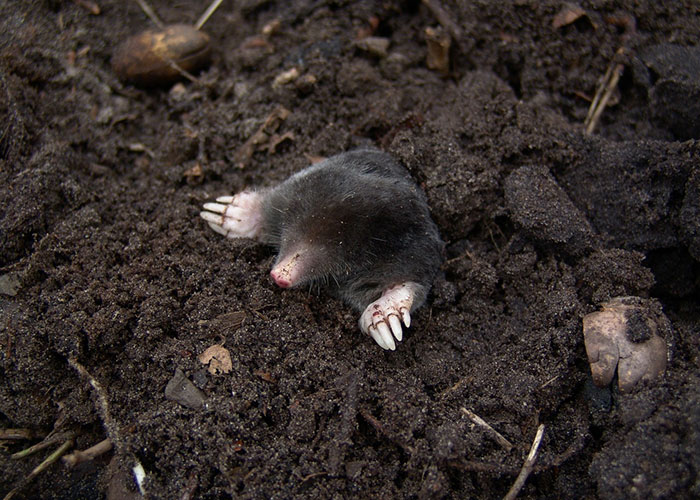
Moles & Voles
These two burrowing critters are often confused with each other, but their roles in the garden are actually quite different.
Moles (pictured first) are larger than voles, and significantly, they have very little to no interest in eating your plants! In fact, they have a helpful role to play from a gardener’s perspective: they eat a variety of pests, from slugs to cranefly larvae. They also enjoy other soft bodied insects, and earthworms.
Unfortunately, in the course of digging their tunnels, moles can inadvertently uproot plants. But unless the population is very large, the damage they cause tends to be mostly superficial, and can often be repaired by replanting the upturned plant if caught quickly. While there are a variety of options for limiting mole activity in your garden that may be worth a try, your best option may well be to learn to live with them.
Voles (pictured second) are a different story. Much smaller than moles at only about five inches long, they are herbivores that are especially fond of munching plant roots. If you find mysteriously collapsed plants and dig them up to find that their entire root system has been eaten, or you see one-inch wide “runways” criss-crossing your lawn or garden, you are probably dealing with voles.
Individual plants or garden beds can be protected from voles with wire cages that extend six inches into the soil. You can also limit vole habitat and tip the scales in favor of their natural predators such as owls by limiting available cover. If you have a vole issue, it’s a good time to keep grass mowed, move any leaf or stick piles that have been hanging around for a while, and consider any other ways you might be able to help out airborne hunters.
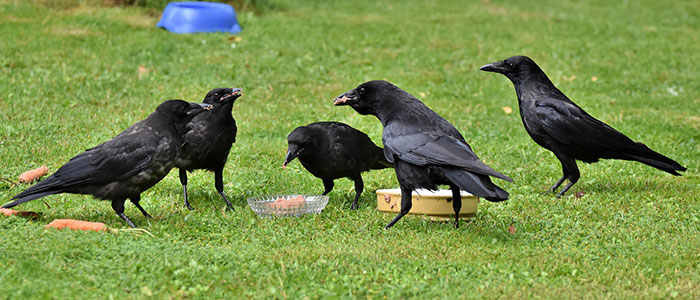
Crows, Jays, & other Birds
No, not Covid: Corvid. That’s the family of birds that both crows and jays belong to. These super-smart birds can be a lot of fun to observe and certainly deserve our respect, but they can also make quite a nuisance of themselves around the garden.
One particularly challenging habit: they have been known to watch a gardener plant big, tasty seeds like corn or peas and then follow along plucking out each and every one. They also sometimes pluck whole seedlings out of the ground, or take a notion to snack on some ripe fruits and veggies. And as highly social animals, they will often invite their whole circle of family and friends along for a feast.
Smaller song birds, while generally welcomed by wildlife gardeners, can also become pests when they descend on our berries or seeds in large numbers.
Using bird netting or another barrier to physically exclude birds is the best way to manage these winged garden guests. You probably don’t want to put a net over your entire garden, but you can cover particularly tasty berry bushes, seed heads that you would like to save, and freshly planted seed as needed.
Another strategy is to plant abundant and diverse bird-attracting plants, so that you have plenty to share.
Finally, you can also avoid attracting unduly large numbers of corvids by keeping meat and dairy out of open compost piles and making sure to secure your trash and compost bins.
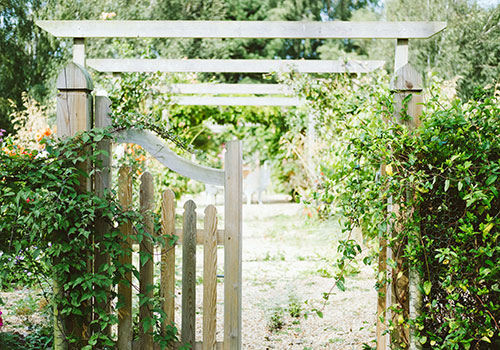
Peaceful Coexistence
In the end, ecological pest management for birds and mammals is best accomplished with a little bit of prevention and quite a lot of acceptance. These critters are here to stay, and our job as gardeners is to learn how to set what boundaries we can while also graciously sharing their space. Happy gardening!

